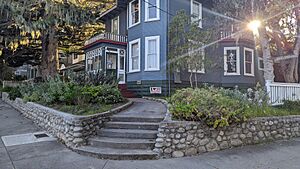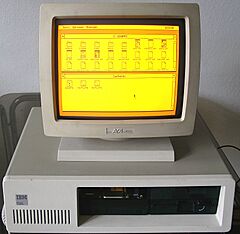Digital Research facts for kids
 |
|

Original headquarters of Digital Research on 801 Lighthouse Ave, Pacific Grove, California. On the sidewalk, to the left, is a commemorative plaque.
|
|
| Private | |
| Industry | Software |
| Fate | Acquired by Novell |
| Founded | 1974 in Pacific Grove, California, United States |
| Founder | Gary Kildall |
| Defunct | 1991 |
| Headquarters |
|
|
Key people
|
|
| Products | Compilers, operating systems, graphical user interfaces |
| Revenue |
|
|
Number of employees
|
|
Digital Research, Inc. (also known as DR or DRI) was an American software company. It was started by Gary Kildall. The company's main goal was to sell and improve his CP/M operating system. They also worked on other systems like MP/M, Concurrent DOS, FlexOS, Multiuser DOS, DOS Plus, DR DOS, and GEM. Digital Research was one of the first big software companies for microcomputers. It was first located in Pacific Grove, California, and later moved to Monterey, California.
Contents
History of Digital Research
How Digital Research Started
In 1972, Gary Kildall was a teacher at the Naval Postgraduate School. He also worked as a consultant for Intel. By 1974, he created a program called Control Program/Monitor, or CP/M. This was the first disk operating system for microcomputers.
In 1974, Kildall officially started his company. It was first called Intergalactic Digital Research. His wife helped manage the business side. Soon, the company became known as Digital Research. Their operating systems, especially CP/M, became very popular. They were used on many early computers. Digital Research also made MP/M in 1979. This was a version of CP/M that could run many tasks at once. It also allowed multiple users to use the computer.
CP/M and Competition with MS-DOS
Microsoft later released MS-DOS. This operating system was based on ideas from CP/M. In response, Digital Research released CP/M-86 in 1981. This was a 16-bit system. It was designed to compete directly with MS-DOS. They also made MP/M-86 in 1981, which was a multi-tasking system. In 1982, they released Concurrent CP/M. This allowed a single user to run several programs at the same time.
By 1983, Digital Research was a major software company. They had sales of $45 million. They also partnered with AT&T Corporation in 1984. This partnership aimed to create software for Unix System V.
Digital Research also created many programming language tools. These included C, Pascal, COBOL, and BASIC.
Digital Research developed CP/M-86 as an alternative to MS-DOS. It was available through IBM in early 1982. The company later made an MS-DOS-like system called DR DOS. This system had more advanced features. It pushed Microsoft to make its own DOS better.
When the IBM Personal Computer was being developed, CP/M was the most popular operating system. In 1980, IBM asked Digital Research to provide a version of CP/M for their new PC. However, Digital Research did not agree to IBM's terms.
Microsoft then took this chance to provide an operating system for the IBM PC. The IBM PC came out in late 1981 with PC DOS. This was a version of MS-DOS. By mid-1982, MS-DOS was also sold for other computers. This decision helped Microsoft become a leader in computer software.
The competition between MS-DOS and DR DOS was very intense. Microsoft offered better deals to computer makers. This made it hard for them to offer other operating systems. This practice was later investigated by the US government.
Digital Research continued to improve its systems. Concurrent CP/M later added features to run MS-DOS programs. These versions were called Concurrent DOS (1984) and Concurrent PC DOS (1984).
In 1985, Digital Research released a real-time system. It was first called Concurrent DOS 286. Other single-user systems were also launched. These included DOS Plus (1985) and DR DOS (1988). DR DOS was sold as a direct replacement for MS-DOS. It became a very successful product.
Graphics Environment Manager (GEM)
In 1985, Digital Research also created GEM. This was a GUI. A GUI lets you use a computer with pictures and icons, not just text commands. After GEM, Microsoft introduced Windows 1.0.
Digital Research believed that Microsoft sometimes announced new versions of MS-DOS too early. This made people wait for Microsoft's products instead of buying DR DOS.
FlexOS and Multiuser Systems
Concurrent PC DOS later became FlexOS in 1986. This system used the new computer processors better. It allowed for more flexible multi-tasking. FlexOS became popular in systems like those used at checkout counters in stores.
Other versions of Concurrent DOS were Concurrent DOS XM (1986) and Concurrent DOS 386 (1987).
In 1991, DR introduced Multiuser DOS. This was part of Digital Research's family of operating systems that allowed many users at once.
There was a time when Microsoft included hidden code in a test version of Windows 3.1. This code would detect DR DOS. It would then show an error message. This made people think DR DOS was not compatible with Windows. Later, it was found that Microsoft executives planned this to hurt Digital Research's business.
Digital Research Joins Novell
Digital Research was bought by Novell in 1991 for $80 million. Novell mainly wanted Digital Research's operating systems. FlexOS was one of these systems. It was already used as the base for other systems like:
- Siemens S5-DOS/MT
- IBM 4680 OS
- 4690 OS
DR Multiuser DOS also developed into other products. These included Datapac System Manager and IMS REAL/32. Novell continued to develop the DR DOS line. This led to products like Novell PalmDOS and Novell DOS. Novell later sold the DR-DOS product line to Caldera in 1996. Caldera wanted a DOS operating system for its OpenLinux software.
Caldera
Caldera (company)
Notable People at Digital Research
Many important people worked at Digital Research. Some of them later made big contributions to the computer world. These include:
- Gary Kildall, who had a Ph.D. in Computer Science.
- Kathryn Strutynski, who had a master's degree in computer programming. She helped Kildall create CP/M. She was the fourth employee at Digital Research.
- Gordon Eubanks
- Tom Rolander
- Lee Jay Lorenzen
- Don Heiskell
- John Meyer
- Edward R. McCracken
Company Acquisitions
Digital Research bought other companies to get their software products:
- Compiler Systems, Inc. (1981) for CBASIC
- MT MicroSYSTEMS, Inc. (1981) for Pascal/MT+
See Also
- Multiuser DOS Federation
- Novell Digital Research Systems Group
- Caldera Digital Research Systems Group


